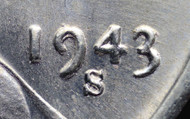Experts Confirm 1943/1942-S Wartime Lincoln Cent is an Overdate
Posted by Bullion Shark on Jun 8th 2022
1943/1942-S Wartime Lincoln Cent
Despite being one of the most widely collected American coin series, Lincoln cents continue to provide fertile ground for the discovery by collectors and experts of new die varieties -- even with coins of existing die varieties.
A case in point is a well-known 1943-S Lincoln cent with Doubled Die Obverse that was discovered many years ago that was recently reassessed as being both that and a 1943/1942-S overdate variety. This major numismatic discovery, which has been confirmed by some of the leading experts on Lincoln cents and on die varieties, has not yet received widespread confirmation as some collectors remain skeptical, and coin price guide editors are mulling over whether to include it in their publications and websites.
It is healthy for the hobby and for Lincoln cent collectors in particular that such new discoveries are made, as they help stimulate further interest in the coins, and also healthy that those in the hobby and expert community thoroughly vet such discoveries.
1943-S Lincoln Doubled Die Variety
As recounted by longtime coin writer Tom DeLorey recently in several different numismatic publications including Coin World and CoinWeek, in early May longtime collector James Elliot contacted him to explain that another collector recommended that he contact DeLorey regarding a 1943-S Lincoln that was a known doubled die variety that he also thought was a 1943/1942-S overdate variety.
This coin has long been listed as a doubled die obverse variety in Bill Fibas’ Cherrypickers’ Guide that refers to it as FS-101, which is also how it is listed in NGC’s Variety Plus website. Such doubling is the result of two impressions of the hub. But as NGC notes, the coin is also an overdate: “Long thought to be simply a doubled-die resulting from two impressions of the 1943 hub, in 2022 this was confirmed to be an overdate. The initial hubbing was dated 1942, and this was subsequently impressed with the 1943 hub.
NGC’s census notes that a total of six such coins have been graded by the service to date.
Elliot has first discussed the possibility of this coin also being an overdate back in July 2020 in a Facebook forum, “Lincoln Cent Errors and Varieties Only,” where he noted “the extra metal to the upper right side of the 3 matches a 2.” He also provided overlaid photos to make the same point, and DeLorey’s expert colleagues confirmed that this extra metal can’t be accounted for if the coin were only a doubled date variety with doubling in the north-south direction.
Another die variety specialist, James Wiles, also created a photo overlay that DeLorey believes shows that the “blob of raised metal to the right of the top of 3 cannot align with any part of a 3 that is doubled only north and south.”
DeLorey further explained that the reason the base of the 2 on this coin is missing and the upper right curve of the 2 is weak has to do with the way the hubbing process was done at the time.
In particular, if the second or third time the hub made impressions it came from a hub with a different date than the first one, the result is an overdate. He believes this could have occurred towards the end of any year when current date dies were still being used while those for the coming year were being prepared, which is also how other rare overdate coins were created such as the 1918/1917-D Indian Head cent or the 1943/1942-P Jefferson cent.
One collector who is not convinced made this comment on Facebook: “I'm not convinced. The second underlying date is southwest of the primary date. If there was a 2 under the 3 then this point at the base of the 2 would be lower, level with the base of the underlying 4. (Just look at a 1942 cent to see the base of the 2 is level with the base of the 4). The point shown in the red circle is just too high. It is just the center of a 3. This is a 1943 S double die, not an overdate. The "experts" here were too anxious to declare they found some Holy Grail.”
Furthermore, it is hardly coincidental that such errors occurred more frequently during wartime (with six of the seven major modern overdates having been produced during World War II) because the Mint would have been less likely during that period to destroy a die with an error that was still useable for striking coins.
This reevaluation of an existing die variety once again proves that collectors should continue looking closely at their coins and studying the latest information about them.
Sources:

